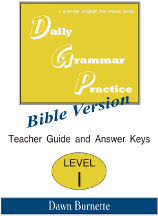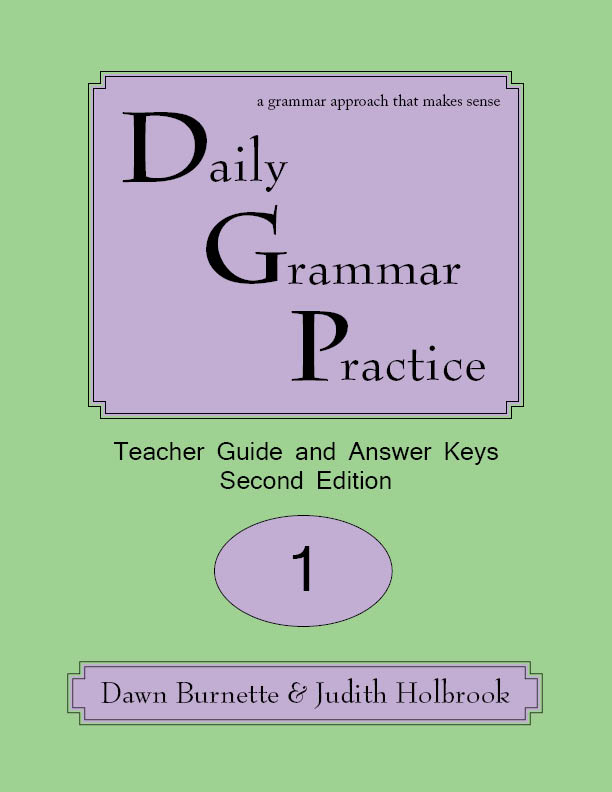Daily Grammar Practice courses for grades one through twelve present a method for teaching grammar that always teaches the elements of grammar and usage in context and requires only a little time each day. It would be best to use this series over a number of years since it builds gradually from level to level.
Each week, students work with one sentence, completing different activities with that sentence each day. Levels 1 through 4 use sentences written by the authors, but levels 5 through 12 use sentences from literary works in most lessons. First editions of these courses were called Grade 1, etc., but the second editions have dropped the word “Grade” leaving only a number. This is helpful since these books need not be used at particular grade levels.
The pattern of activities for Monday through Friday is identical through 30 weeks of lessons in each course. While the activities might seem daunting the first few weeks, they are likely to become more manageable as students become familiar with the routines. A brief paragraph on “teaching points” is at the top of each week’s lesson. Teaching points might include one or more concepts that require some explanation each week. This incremental method of introducing new concepts while continually practicing and applying what they have already learned helps students to truly master grammar.
The first week’s lesson in the first level begins with instructions to identify each noun (common noun, proper noun, and possessive noun), pronoun, interjection, adjective, preposition, and conjunction. (Note that all of these parts of speech except interjections are included in the Common Core requirements for first-grade level, but these are to be learned over the course of the year.) The second day, students identify action verbs as well as the noun or pronoun that is doing the action. On Wednesday, they determine which of the four types of sentences it is. On Thursday, they capitalize and punctuate the sentence, and on Friday, they write their own sentence that contains specific parts of speech and is the same type of sentence as the sentence used for the rest of the week’s lessons. All of the activities for each week are presented on a single page.
While you can begin using the first level with first graders, I suspect that you might want to wait until at least the second semester of first grade so that you have time to lay some groundwork before jumping into this program. The sentence for the first week of the first level is presented to students as: “josh likes red apples.” You can see that this is a fairly simple sentence, so students need not worry about pronouns, interjections, prepositions, or conjunctions, yet many first graders at the beginning of the school year will need to learn about nouns, verbs, pronouns, and adjectives, capitalization, and punctuation before tackling this exercise. Of course, you can also wait until second grade or later to use the first level.
For all levels, the teacher guides suggest brief instruction or review during the first week of the school year before beginning lessons in Daily Grammar Practice (DGP). In the first level, there are “poster” pages with the names and definitions of some parts of speech. Clearly, you are expected to use these as teaching aids.
Each teacher guide and student workbook for all levels also has a section of “Help Pages” with brief notes on grammatical concepts that will be taught and reviewed. These are arranged under the days of the week on which they are applied, which makes it easier to find what is needed quickly. The Help Pages are designed for students to learn as they go by referring to these pages for the information they need for each day's assignment. Help Pages include models of various sentence diagrams under “Friday Notes” for level 4 and above. Grammatical concept explanations on the Help Pages are brief bullet points rather than lessons, so they are most useful for reviewing concepts that students have already learned. Parents or teachers might need to go over some of these with students if they need additional explanation. However, working through the lessons with the Help Pages pushes students to figure things out on their own—an excellent way to really master the skills. Once students have a basic grasp of the parts of speech, simple punctuation, and capitalization, new concepts are introduced within the context of the DGP lessons as specified in the teaching points.
As you would expect, new concepts are taught at each level, and sentences become lengthier and more complex. Sentence diagrams are introduced for Friday’s activity beginning with the fourth level and are included in all subsequent levels. By the ninth level, students are identifying parts of speech and syntax for all words in the sentence. They also identify clauses and diagram complex sentences.
Two versions of a pre-test are included at the back of each teacher guide. These are almost identical to one another. The authors suggest that you might use one before beginning the course and the other at the end. Pre-tests ask some questions based on concepts that have not yet been taught, so students will likely miss at least a few items at the beginning of the course. (It seems to me that you might instead use a pre-test as a post-test, although it doesn’t test every new concept taught that year.) There is also a Quiz Template that you can use at any point. The quiz follows the same progression as the daily activities for one week, although you would have a student complete it in one sitting. You will insert your own sentence, which means you can use this template for more than one quiz if you wish.
Three explanatory chapters at the beginning of each teacher guide thoroughly explain how the program works and include helps such as the aforementioned grammar guide, explanations for each day’s activities, a “Marking Guide” that shows abbreviations and markups students will use on their sentences, and a reproducible list of the sentences used for all of the lessons that also includes the daily instructions for that level. While you can purchase inexpensive student workbooks, you are also given permission to copy the page(s) of sentences with instructions, the Marking Guide, and the Help Pages to hand out to students. Students can then copy the sentence each day and follow the directions, most likely working on lined paper. Teacher guides show the answers for each entire week on a single page.
At younger levels, teachers or parents need to work more closely with children than at upper levels. At all levels, some teaching is required since teaching points are only in the teacher guides. However, students should gradually be able to complete more and more of their work independently.
In “Some Words of Caution” in Chapter Two of each teacher guide, the authors stress that teachers and parents “must know grammar well to teach it well.” Teaching points tell you what to teach but not how to teach it. For example, the first week of the fifth level says, “Discuss capitalization rules, the use of the apostrophe to show possession, and prepositional phrases” (p. 23). Parents or teachers can refer to the brief notes in the Help Pages, but unless they are really familiar with each topic, this might not be enough guidance for presenting these topics to students.
The authors recommend that those who are weak on grammar study the Help Pages before teaching a course. The authors also recommend that the parent or teacher also practice completing the exercises with the student sentences before trying to teach to make sure that they understand each lesson and can explain to students if necessary. DGP requires more from the teacher than do some grammar courses because instructions for teaching new material are not detailed.
DGP Academy Video Teaching
For parents or teachers who need help with the teaching, there are now DGP Academy videos with daily instruction for all of the lessons—150 videos per level. The instruction is presented by the series author Dawn Burnette. You can watch these brief lessons (about three minutes each) to learn how to teach each lesson yourself, or you can have students watch. Students should have worked on the day's assignment on their own before watching the video or being instructed. If you use DGP Academy videos, you still need the teacher and student books.
You purchase access to the videos one grade level at a time, and your access does not expire. The purchase price includes a free printed copy of the corresponding teacher's edition.
Advanced Second Editions
Second editions of the books for grades six through twelve are also available. Rather than replacing the first editions, these offer more challenging work. While they address the same grammar skills, they draw on literature for the sentences. These sentences are lengthier and use more sophisticated language. To contrast the difference, here is the sentence for the first week of the first edition ninth-grade book: "Their team will practice after school." The corresponding sentence in the second edition book is, "What's the object of your journey, sir?"
DGP Bible Versions
 Dawn Burnette has written a parallel series of DGP Bible Versions, presented in Levels I through VI. These courses use Bible verses (from both the NKJV and NIV versions) and Bible-related sentences for study each week.
Dawn Burnette has written a parallel series of DGP Bible Versions, presented in Levels I through VI. These courses use Bible verses (from both the NKJV and NIV versions) and Bible-related sentences for study each week.
While the author says that students as young as ages six or seven might use Level I, the scope and sequence for that level appears to be about third or fourth grade. Burnette says that she intentionally labeled this series as levels rather than grades since most students without a strong grammar foundation that includes sentence diagramming will need to start in Level I. In this level, students identify various types of nouns, personal pronouns, adjectives, action verbs, linking verbs, simple subjects, simple predicates, and interjections. They begin with sentence diagrams that include adjectives, continuing through sentences with prepositional phrases and compound objects. DGP Bible Version Level VI compares with Level 12 in the regular version.
This parallel series is very similar in structure to the other series, with just a few minor differences. The scope and sequence does not line up exactly between the two series, there are no pre-tests in the Bible Versions, and each teacher guide includes a two-page list for the teacher that contains each week’s sentence with the teaching points for that week. The last feature is especially helpful since it makes it easy to look ahead to see what new information is taught each week.
Digital Versions
DGP Publishing has apps for the basic Daily Grammar Practice books. These are interactive programs and activities that cannot be printed. Students work entirely online. I haven't reviewed them, but they are inexpensive and might be a great option. Check the publisher's website for more information.
Free Grammar Practice
One additional related resource might be useful. Daily Grammar Practice: Quick and Simple Tips for Language Learners offers suggestions and free online grammar practice.
Summary
In some ways, DGP looks like Daily Grammar (the companion courses for Easy Grammar), but it is different in purpose and design. While Daily Grammar is designed to reinforce and review material previously taught in a comprehensive grammar course, Daily Grammar Practice is intended to be both your primary source of instruction and your method for regular review and practice. So don’t confuse these two series of courses with similar titles.
DGP courses are challenging and thought-provoking. Students really have to think to complete most of the activities.
I think Daily Grammar Practice will work best for homeschooling parents who are relatively confident in their grammatical knowledge and who have had at least some prior experience with sentence diagrams.








